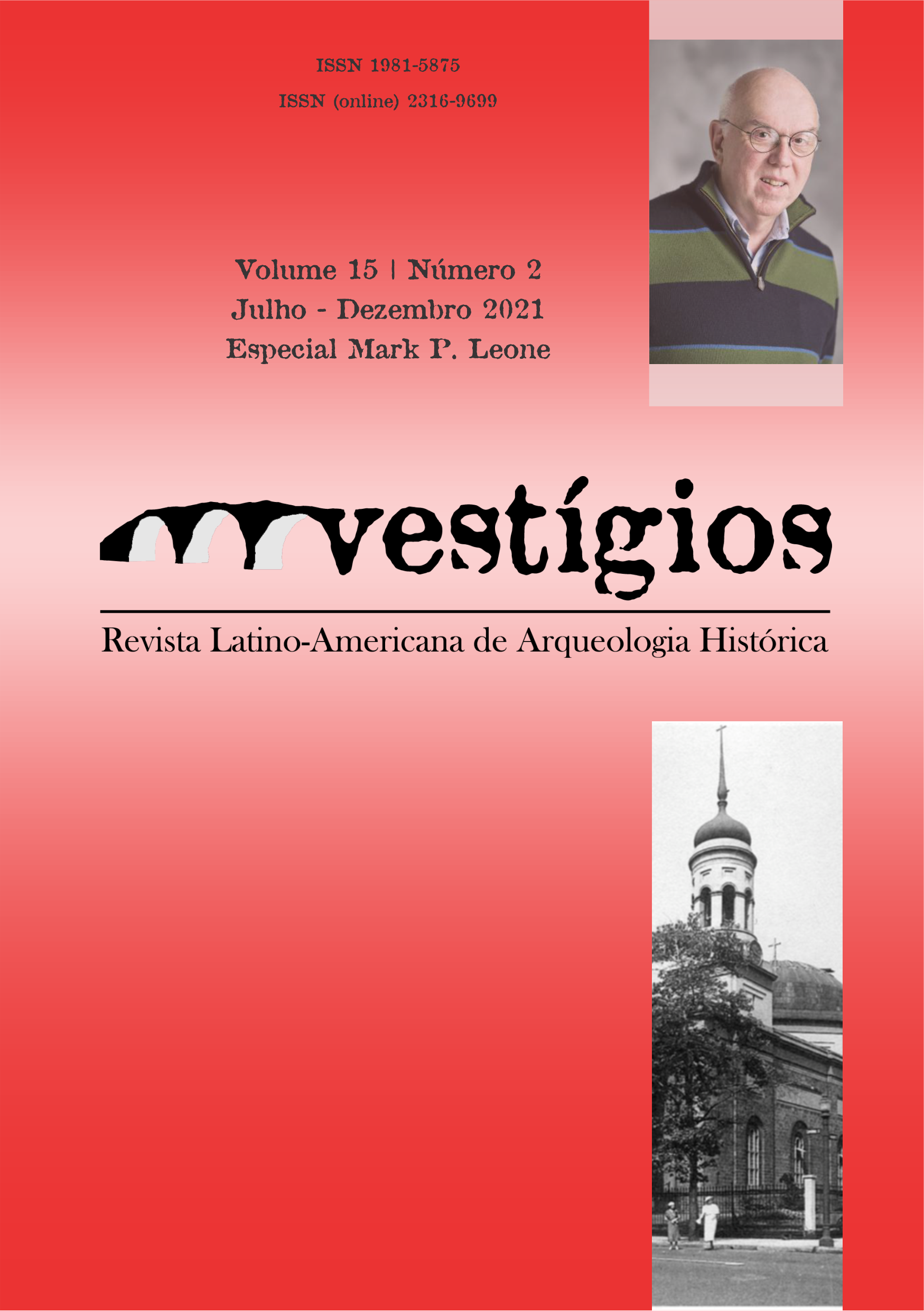Interpreting ideology in Historical Archaeology
using the rules of perspective in the William Paca garden in Annapolis, Maryland
DOI:
https://doi.org/10.31239/vtg.v15i2.35404Keywords:
Historical Archaeology, Ideology, Annapolis, MarylandAbstract
This chapter focuses on the manner in which ideologically informed representations serve to naturalise the arbitrary nature of the social order. The construction of an eighteenth-century garden is shown to employ a number of means towards this aim. Through the use of classical quotations and the development of a concept of precedence with juridical associations, the garden presents a particular rationalisation of time, which also denies its own transient nature. Its geometry and optics exemplified in its use of perspective, serve towards a controlled rationalisation of space. Overall the garden not only acts as representation but also works as an instrument for the close experimental observation and control of nature. The garden and the segmented and ordered form of Georgian architecture can be related to the contradictions of a society proclaiming freedom and independence but maintaining a system of slavery. The deliberately planned wilderness garden exemplifies such contradictions.
Downloads
References
Althusser, L. (1971). Ideology and Ideological State Apparatuses. In Lenin and Philosophy, pp. 127-86, Monthly Review Press, New York
Breen, T.H. (ed.) (1976). Shaping Southern Society, Oxford University Press, New York.
Charles Carroll Letterbook (1760). September. Hall of Records, Annapolis, Maryland.
Cohen, P. C. (1981). Statistics and the State: Changing Social Thought and the Emergence of a Quantitative Mentality in America, 1790-1820, William and Mary Quarterly, Third Series, 38 (1), p. 35-55.
Deetz, J. F. (1977). In Small Things Forgotten, Doubleday, Garden City, New Jersey.
Farish, H. D. (ed.) (1943). Journal and Letters of Philip Vickers Fithian, 1773-1774, Plantation Tutor of the Old Dominion, Colonial Williamsburg Inc., Williamsburg, Virginia.
Glassie, H. (1975). Folk Housing in Middle Virginia, University of Tennessee Press, Knoxville,
Greene, Jack P. (ed.) (1965). The Diary of Colonel Landon Carter of Sabine Hall, 1752-1778. vol. 1, The University of Virginia Press, Charlottesville, Virginia.
Gurevich, A. J. (1976). Time As a Problem of Cultural History'. In Ricoeur, P. (ed.), Cultures and Time, p. 229-45, The Unesco Press, Paris.
Isaac, R. (1982a). The Transformation of Virginia 1740-1790, University of North Carolina Press, Chapel Hill.
Isaac, R. (1982b). Terrain, Landscape, Architecture, and Furnishings: Social Space and Control in Old Viiginia. Paper read at the twenty- second annual meeting of the Northeastern Anthropological Association, Princeton, N.J.
Klapthor, M. B., & Morrison, H. A. (1982). G. Washington, A Figure Upon the Stage, Smithsonian Institut Press, Washington, D.C.
Langley, B. (1726). New Principles of Gardening, Bettsworth and Batley, London
Le Blond, A. (1728). The Theory and Practice of Gardening, Bernard Lintot, London
Levi-Strauss, C. (1963). Split Representation in the Art of Asia and America. In Structural Anthropology, p. 245-68. Basic Books, New York
Little, J. G., II (1967-8). Re: Archaeological Research on Paca Garden. November 8,1967, May 24,1968. Letters on file, William Paca Garden Visitors' Center, Annapolis, Maryland.
Lukacs, G. (1971). Reification and the Consciousness of the Proletariat. In History and Class Consciousness, M.I.T. Press, Cambridge, Mass.
Miller, P. (1733). The Gardener's Dictionary. Printed for the author. London.
Okoye, F. N. (1980). Chattel Slavery as the Nightmare of the American Revolutionaries'. William and Mary Quarterly: Third Series, 37: l, p. 3-28.
Orr, K. G., & Orr, R. G. (1975). The Archaeological Situation at the William Paca Garden, Annapolis, Maryland: The Spring House and the Presumed Pavilion House Site. April', Typescript on file, William Paca Garden Visitors' Center, Annapolis, Maryland.
Papenfuse, E. C. (1975). In Pursuit of Profit: The Annapolis Mechants in the Era of the American Revolution, 1763-1805, Johns Hopkins University Press, Baltimore, Maryland.
Powell, B. B. (1966). Archaeological Investigation of the Paca House Garden, Annapolis, Maryland. November 16, 1966', Typescript on file, William Paca Garden Visitors' Center, Annapolis, Maryland.
Rowe, J. H. (1965). The Renaissance Foundations of Anthropology'. American Anthropologist, 67, p. 1-20.
Shanks, M., & Tilley, C. (1982). Ideology, Symbolic Power and Ritual Communication: A Reinterpretation of Neolithic Mortuary Practices. In Hodder, I. (ed.), Symbolic and Structural Archaeology, Cambridge University Press.
South, S. (1967). The Paca House, Annapolis, Maryland. Unpublished ms., Historic Annapolis, Inc., Annapolis, Maryland.
Stiverson, G. A., & Jacobsen, P. R. (1976). William Paca, A Biography. Maryland Historical Society, Baltimore, Md.
Tate, T. W., & Ammerman, D. L. (1979). The Chesapeake in the Seventeenth Century. Norton and Co., New York.
Thorpe, I. J. (1981). Anthropological Orientations on Astronomy in Complex Societies. Paper read at the Third Theoretical Archaeology Conference, Reading, U.K.
Woodfin, M. H. (ed). (1942). Another Secret Diary of William Byrd of Westover, 1739-1741, The Dietz Press, Richmond, Virginia.
Wright, L. B., &Tingling, M. (eds.) (1963). The Great American Gentleman William Byrd of Westover in Virginia. His Secret Diary for the Years 1709-1712, Putnam's Sons, New York, G.P.
Yentsch, A. E. (1982). Letter on Spring House Excavations, William Paca Garden. 15 March, on file, William Paca Garden Visitors' Centre, Annapolis, Maryland.
Downloads
Published
How to Cite
Issue
Section
License
Copyright (c) 2021 Mark P. Leone; Pedro Fermín Maguire

This work is licensed under a Creative Commons Attribution-NonCommercial 4.0 International License.

O trabalho Vestígios - Revista Latino-Americana de Arqueologia Histórica de https://periodicos.ufmg.br/index.php/vestigios/index está licenciado com uma Licença Creative Commons - Atribuição-NãoComercial 4.0 Internacional.
Baseado no trabalho disponível em https://periodicos.ufmg.br/index.php/vestigios/index.
Podem estar disponíveis autorizações adicionais às concedidas no âmbito desta licença em https://periodicos.ufmg.br/index.php/vestigios/index.


